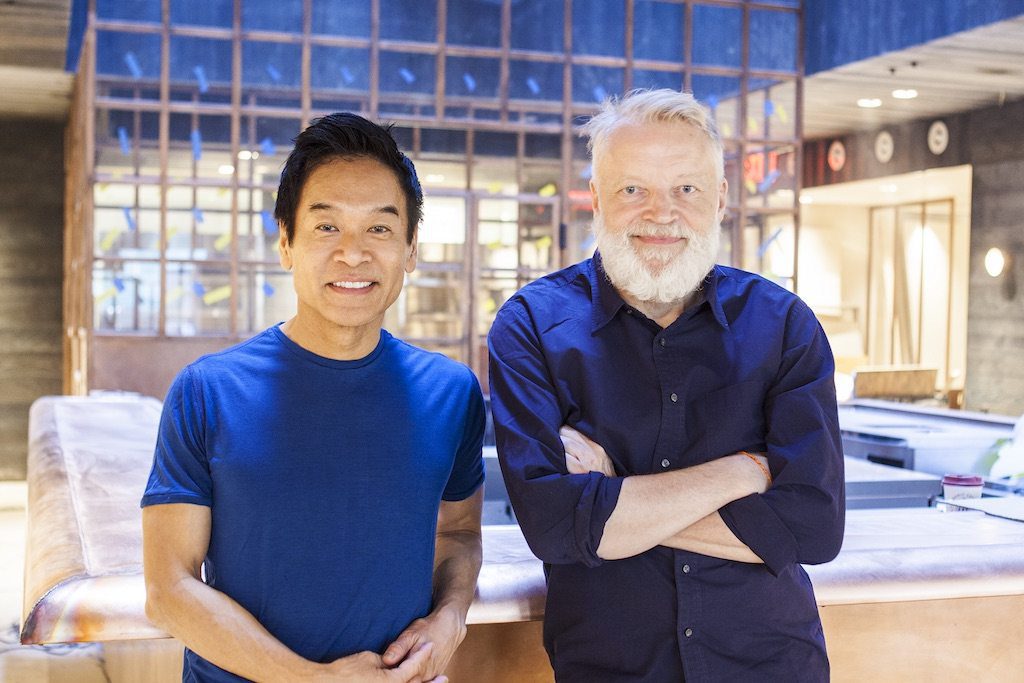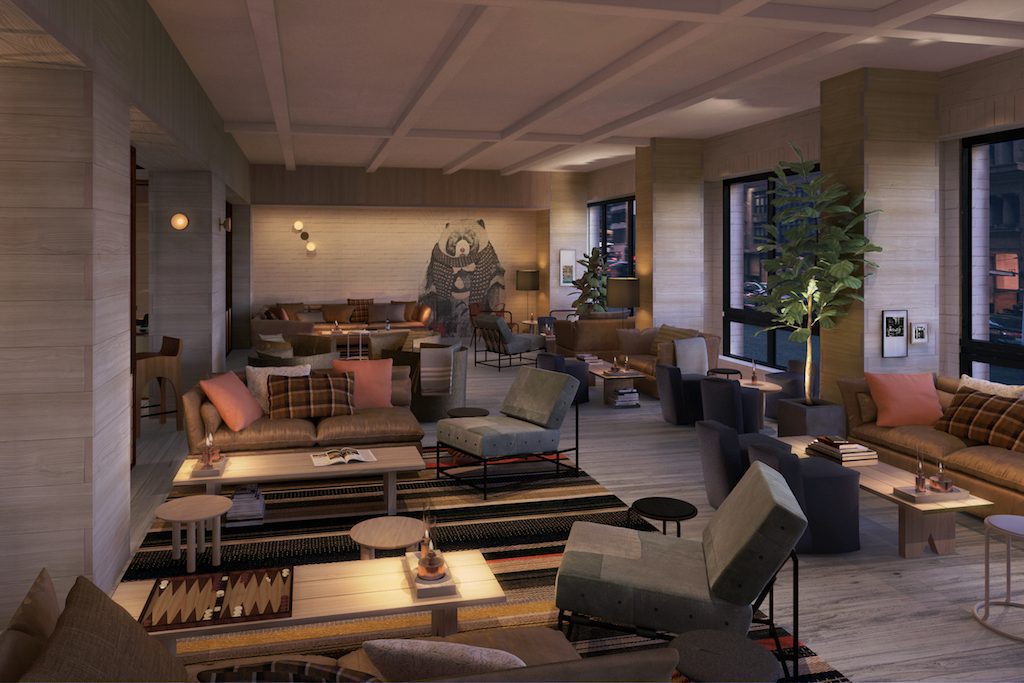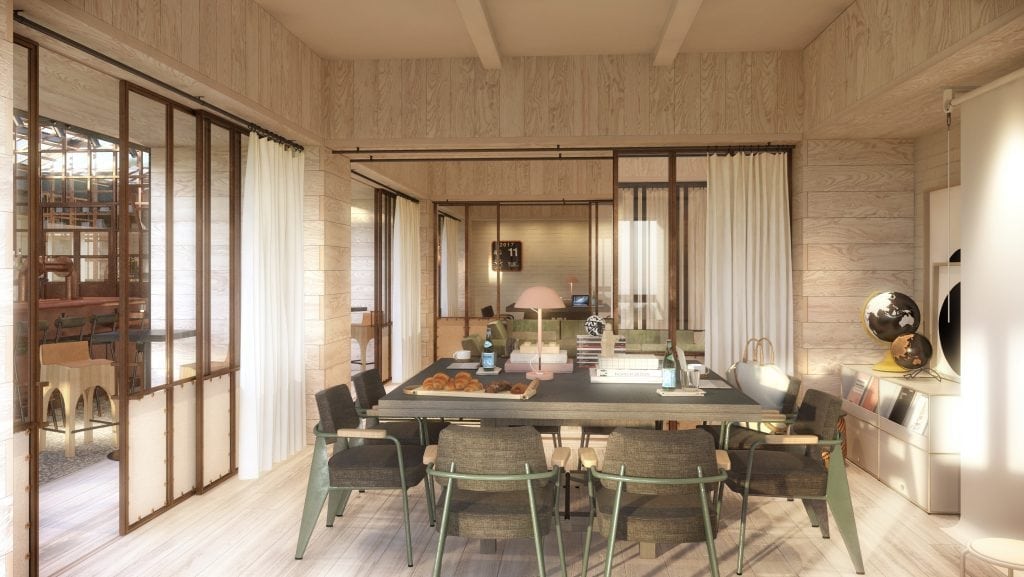Skift Take
The future of hotel design might be on a smaller scale, but Yabu Pushelberg knows the design aspirations and expectations will be even greater than they have been before.
Toronto- and New York City-based designers George Yabu and Glenn Pushelberg have designed properties for some of the biggest names in hospitality for nearly 40 years. Their clients and brands include Ian Schrager, the Four Seasons, Park Hyatt, and the St. Regis, among them.
But their newest hotel project isn’t being marketed as a luxury product. Instead, it’s the 612-room Moxy Times Square, Marriott’s answer to guests who want a hotel that doesn’t forsake style for a lower price point. The property is scheduled to open later this month.
The property’s developer, Lightstone Group, asked Yabu Pushelberg to design the hotel’s guest rooms and public spaces. The Rockwell Group designed the hotel’s dining venues, which will be operated by TAO Group.
The duo, founders of the eponymous firm that bears their last names, are known for their sleek, elegant, contemporary, and sophisticated designs. Translating that design aesthetic to a hotel with much tighter space constraints proved to be a challenge, but one that the two and their design team gladly wanted to undertake. Rooms at the Moxy Times Square range in size from 120 square feet to 350 square feet.
The micro-hotel concept is one that continues to flourish, especially in New York City. This year alone there have been the opening of Schrager’s flagship Public New York, which markets itself as having “luxury for all” and had promoted room rates when it debuted at just $150 a night, although now the rates are often higher. And Pod Hotels, which already has two locations in the city, is planning to add two more — one in Times Square and another in Williamsburg, Brooklyn.
Skift spoke to Yabu and Pushelberg about the unique design challenges presented by micro-hotels, and where the future of hospitality design is headed. This interview has been edited for clarity and length.
Skift: You’re both very well-known for your hotel designs for brands such as the Four Seasons, Le Meridien, Edition, and Park Hyatt, just to name a few. What was it like to work on a project like the Moxy Times Square, for a project that’s not necessarily considered a traditional luxury hotel?
Glenn Pushelberg: We’re actually very keen to do any project that has a reason to be designed and that can enhance the experience through design. What happens is you get pegged into the obvious categories: These are luxury products, these are luxury designers, and they do all those kind of five-star hotels, which is a wonderful thing to do, but we were keen to do the project with Moxy, and projects like the Edition Hotel, and projects like the Equinox Hotel because they aren’t five-star hotels; they’re more of a lifestyle. Myself, I’m focused more on hotels that are designed, basically, to give you a much more positive and interesting and engaging experience.
This kind of micro-hotel trend that’s going on — we thought that it was a unique and interesting challenge. And the client is wonderful in that they allowed us to design anything and everything that we wanted, including the sink in the hotel room and the furniture, and all the different parts of the hotel. And it truly is something that is unique and has a very thought through and thoughtful design to it, and that’s what we’re interested in.
George Yabu: Because no matter what you paid for your room, you want the same thing, essentially. If you stay at the Four Seasons or Park Hyatt, you want to have enough power outlets for all of your electronic devices, and all the spaces you need to live, or work, or play, or eat in your room — all those different areas. You might want to work from the sofa, or you might want to work from the desk. Everybody wants a decent bathroom facility, with good lighting and enough surface space at your vanity. These are principles everybody has, no matter if you go to a luxury hotel or a budget hotel. It’s how you touch people, it’s how you engage people. That’s what we did for Moxy.
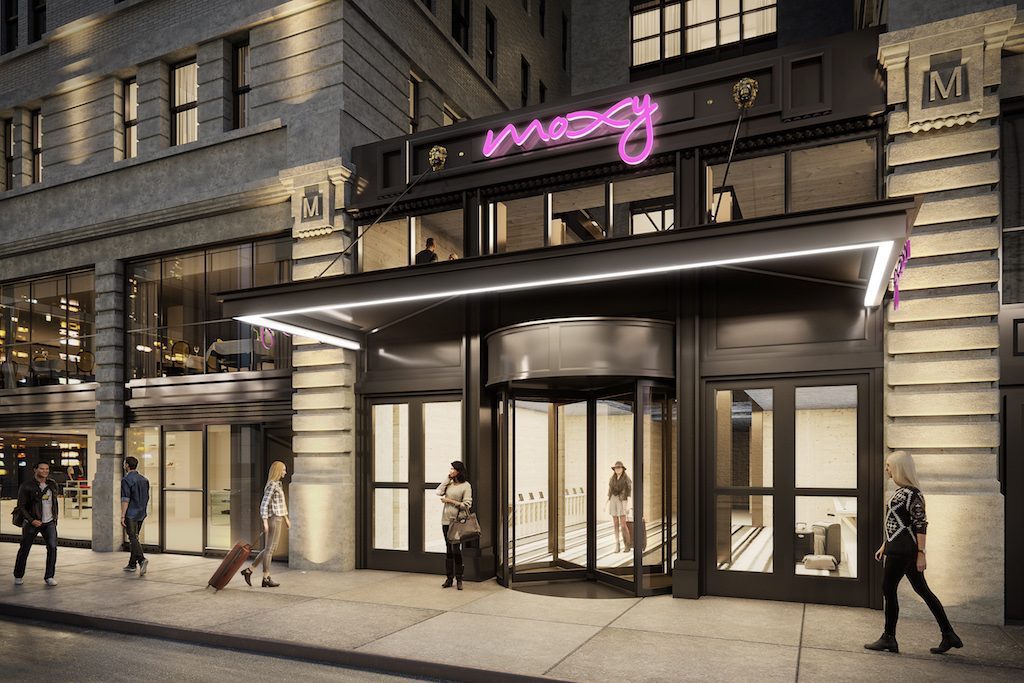
A rendering of the entrance to the new Moxy Times Square, set to open in New York City later this month. Source: Moxy Times Square
Skift: The earlier Moxy properties that first opened in Europe and other parts of the U.S. were sometimes criticized for having designs that seemed a little too cloying, or maybe too Millennial. With the Moxy Times Square project, did you try to counteract those criticisms?
Pushelberg: When we were approached by the developer and also talked with Marriott about the brand, we saw what they did in Europe. We were told by the developer, “We want to make a restart in America and [what was done before is] not appropriate for America; it won’t work.” We agreed with them. They said, “It’s an entry-level or Millennial brand for people who are starting to make a little bit of money and want to stay in a designed, experience hotel.”
We actually took it upon ourselves and said, “You know what? This is a little bit naïve in the approach. The approach really should be that, regardless of how old I am, it’s really for an informed, interested person that doesn’t want to spend a lot of money on a hotel but wants a great experience.”
Once you broaden that approach to it, you create a design that, to us, has some level of familiarity, but it’s not of the past; it’s of the future. It’s not just a modern hotel that’s generic, but it has some emotion attached to it because it feels friendly to you, but it doesn’t feel trite. We’re not trying to appeal to you by thinking, “Oh yes, Millennials like bright colors, they like that nightclub approach or blah, blah, blah.” We wanted something that had a bit of a sincere approach, and it’s distilled.
That was explained in our approach, and it was agreed to by Marriott and the developers thought, “Oh, that makes sense to us.” We believe the Moxy in Times Square does exactly that. It has familiarity, but it’s not a recreation of the past. It’s forward thinking, and it’s intelligent and then it solves all of the central hotel problems that George just mentioned.
Like storage: There are all the things that you need in a tiny little hotel room. It’s very thoughtful in its approach. It has its own character. It has a personality. It will be loved by many. It has longevity to it, too. You can’t label it like, “This hotel is like a Brooklyn hotel or this hotel is like a Millennial hotel.” This is just a great little hotel. It’s a great hotel with sweet little rooms.
Years and years ago we ended a project in Las Vegas for MGM [a renovation of the massive MGM Grand Resort & Casino], and they have the largest hotel in Las Vegas. The original hotel was actually 600 rooms, and they were like motel-sized rooms, and they kept adding and adding and adding. They gave us the challenge to renovate these tiny rooms. We did the reverse room where the bed didn’t face out to the window, because there’s nothing to see, and you never come home until late at night. We faced the bed in and made the room feel bigger, and we made these tricks. [With these new rooms] they actually got a better room rate than they did in much bigger rooms. It’s not the scale of the room, it’s the experience that you create for people that counts.
Skift: Do you see yourselves doing more hotel design projects for brands outside of the luxury realm going forward?
Pushelberg: We are. We’re creating a hotel for Equinox, a high-performance hotel for people on the go. It’s taking the essence of what that type of person who uses Equinox fitness clubs and live the Equinox lifestyle. That’s not a classic luxury brand.
Edition hotels is not a classic luxury brand, either. We did the first three of them, and we’re doing our fourth Edition in Times Square for next year.
What we’re interested in is not necessarily doing luxury. We’re interested in creating new brands for people, or reinventing brands. I think that’s much more interesting than following a brand standard in existing hotels.
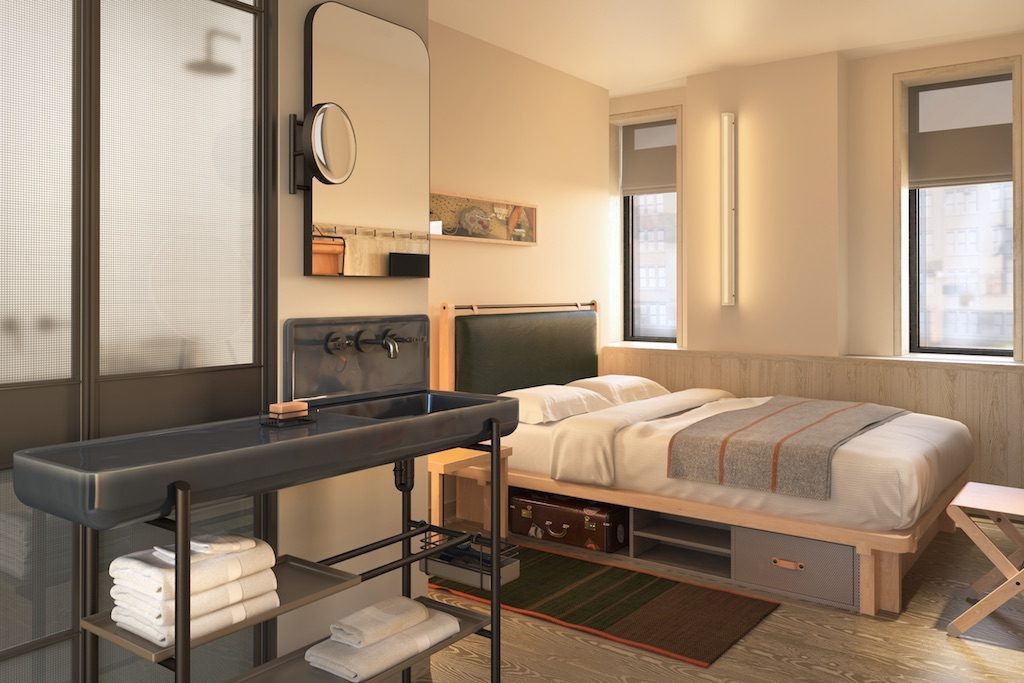
A rendering of a Queen bedroom at the Moxy Times Square. Yabu Pushelberg specially designed the sink featured in every room. Source: Moxy Times Square
Skift: What were some of your favorite details or design elements from the Moxy Times Square and what inspired you most?
Yabu: I think there’s always the romance of staying in hotels in the past. I think that was lost, and a lot of that romance comes from traveling with your parents. When you talk about childhood vacations, for the most part, it’s a very positive experience. Although, perhaps, in reality, it may not have been as wonderful in that respect as it is in your mind.
What we thought we would do is play on the wonderful innocent aspects of vacation days gone by. The old rotary dial telephone. Going to the resort swimming pool. What we did with the shower tiles, it says “No diving.” That sort of response to a memory that you had in the family vacation going down to Florida for example.
One could say these are old clichés, but you have to give it a twist, a little bit of wit if you’re going to rejig these visual memories. Even in the doors that we did for the hotel, going down the going down the corridors, they’re almost like little windows. It’s like going to school, back to school. There were those schoolroom doors with the wired windows, and the little roller blinds for privacy. Obviously, if you are going to do that you can’t be trite, so it had to have a purpose for it. It has messages on it like “Do Not Disturb” on the button.
In high school in Canada we had some buttons on the door when the lab is on. When you’re working in the lab, or you’re working in the darkroom, we have these orange glow buttons for “Do Not Disturb.” When it’s not used for that message, it’s just a light for the corridor. It’s sort of like there are all of these subliminal notions of romantic little happy times, and it’s a little less naïve today because we’re a little bit more aware.
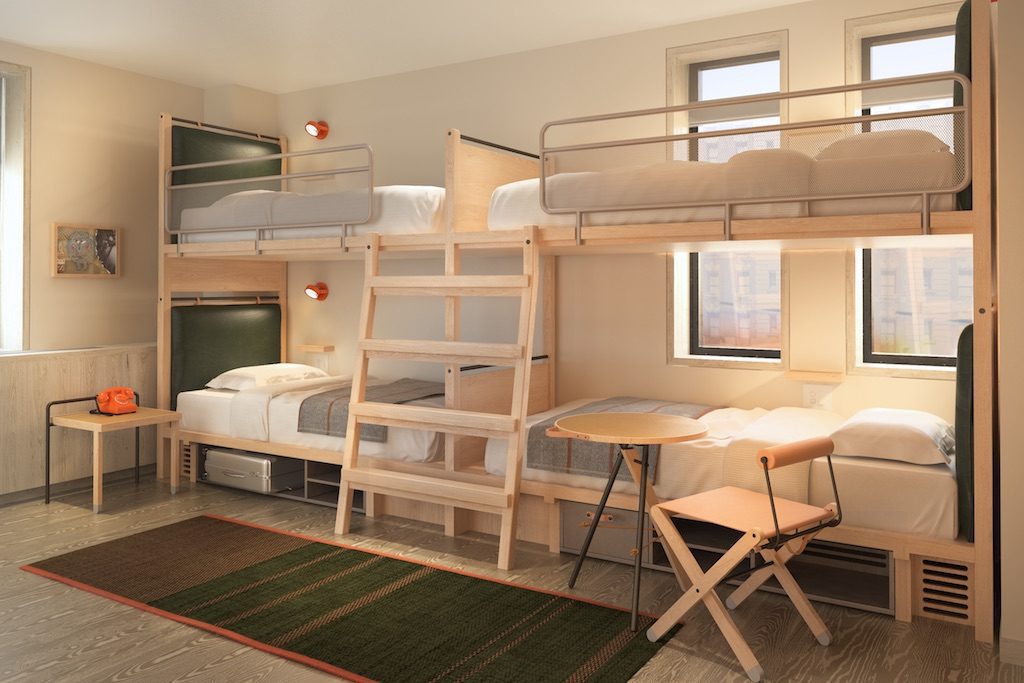
A Quad bedroom at the Moxy Times Square sleeps up to four guests and features a foldable table and chair designed by Yabu Pushelberg. Source: Moxy Times Square
Skift: What were some of the unique design challenges involved with the Moxy project, and what kinds of solutions did you come up with?
Pushelberg: Because of the extreme lack of square footage in the guest rooms, if you didn’t need a desk to work, or you didn’t need one to eat, you could just fold the table and hang it on a hook on the wall. It’s a Shaker design principle that they perfected. Also, you have to do multipurpose furniture.
If you need an extra chair, well, in some rooms you just don’t have space for an extra chair. You can pull away the night table and the night table acts as a chair as well. We had to test it out in terms of live loads and things like that. Visually, you saw there’s a little lumbar support at the back so you know it is something you can sit on. When it’s beside your bed, that lumbar metal tube is a backdrop for your night table.
There’s also lots of storage underneath the bed for your luggage, because you don’t have closets. There’s no space for closets. You have to put your own luggage underneath. There are plenty of hooks, going back to that Shaker notion. It’s basically a continuous peg hook system around the room. You can have spaces for everything. Your towel, your knapsack, your flip-flops, everything. It’s just really cleverly thought out without being, self-consciously, a designer hotel. Things look familiar. “I remember, I remember that. That makes sense.”
With the bathroom of course, you have complete privacy of the water closet. The shower is contained in the bathroom and on the outside, you’ll find the sink space that we had made in France. We have to use the legs of the scepter that holds up the sink. We had to use it to hang the toilet paper and a little shelf trough for the hotel amenities that are provided for free. Everything had to be cleverly thought out, almost like an airplane.
Skift: Do you see micro-hotels design as being the future of hotel design?
Yabu: It’s just the pressure of the growing global travel business. I think that there will be an upward trend in micro-hotels. The cost of real estate in city centers — that’s going to put upward pressure on the size of all hotels, no matter what level.
Pushelberg: With respect to the micro-hotels, I think it’s an emerging part of the hotel market, and a lot of the early examples of it are not that sophisticated. I think, as there is more competition, like with the Moxys that we’re doing, for example, the level of design will elevate itself.
I think that with some of the other [micro-hotels] — I’m not going to name them — but I think it’s Baby Boomer executives pretending to think they know what younger people want out of their hotels. I think it’s a bit naïve. They’re going to be usurped by other more innovative and smarter hoteliers.
Even [Ian] Schrager’s Public hotel is pretending to be a starter brand, but it’s not really because he’s clever. He’s getting rich. He’s getting $400 to $500 a night now; it’s not really entry-level. The design is much stronger, and the experience is much better.
Yabu: Moxy Times Square was designed by this generation that are going to use it. We’re talking about the team within our office. Our muses are our employees.
Skift: Are hotels doing enough to cater to the next generation of hotel guests? Are you seeing the hotel design space evolve in a better way, than from when you first started working in hotel design?
Pushelberg: I don’t know whether it’s a better way, but I think the way we live and what we want out of our life today is continually changing. As everybody reads, we all want experiences, we don’t work in the same way, we work off smaller devices, we don’t live in the same way as we used to. As designers of environments, we have to be tuned into the changes in the way people make their choices about how they live, and so, for example, how we eat and when we eat.
We tend to not just sit in a formal restaurant for breakfast because it’s boring. We want to have the choice whether we want to have a full meal or we want to just graze on something or we want to catch something as we go. We may want to work with people around us in the lobby, we may want a semi-private area.
It’s much more fluid, and so our job is to give people choices to live the way they want to live. Through technology, our life changes. I remember the Joan Rivers movie when she talked about her daughter, Melissa. She was standing in her formal dining room on the Upper East Side of New York with butler service. She says, “I don’t understand why my daughter is eating a sandwich over a kitchen sink for her lunch.” We live a faster life, so we need those choices. I think that we just need to be tuned into the way society changes and the way we live. Hotels need to respond to that.
Skift: You’re also working on the second Moxy hotel that is opening also in New York with the same developer. Is the design going to be similar to the Times Square property or will it be different? Are the two designs that you are doing for these two hotels going to become the new design standard for Moxy going forward?
Pushelberg: The two hotels that we’re doing for Moxy, they have some things that are the same and of course the basic principles are the same. The hotel in the Flower District, the NoMad District, it has some characteristics that we believe belong in the Flower District and that are separate from Times Square. You open up into a garden shop. The materiality of the public spaces responds more to the area that it’s in.
Design-positive hotels shouldn’t be cookie-cutter. They need the connectivity to each other. Our wish would be that as they build up Moxy, things like the furniture can be a connecting thread. There can be changes in the restaurant and some of the public spaces to give the individual hotels a character more appropriate to the place they’re in.
You need to respond to the place. I think that when you go on vacation and you go in the sunshine at Miami, it’s about the light and the airiness and the feeling of being on vacation. In Chicago, which is more serious and gray city, it has a different experience attached to it. The public spaces need to respond to that.
Skift: Has Marriott said anything about taking some of the design elements from the two New York Moxy hotels and incorporating them into future properties?
Pushelberg: We designed this furniture, as George said, that folds up and hangs on the wall — the chairs, the table — a whole bunch of items. We’ve prepared a menu so their developer customers can purchase the furniture for their hotels. We’re hoping that that’s the connected element and it looks like that’s going to happen. They’re promoting that. It makes it easier and faster. It’s great for everyone.
Skift: Any particularly memorable hotel projects that you’ve worked on over the years that really stand out to you?
Pushelberg: I think that working with Ian [Schrager] on the Edition hotel, because it was a game-changer. We just finished a Park Hyatt in Bangkok and Hyatt is a more forward thinking five-star chain and that particular hotel is artistic in its quality, and it’s fluid and it’s modern, but it’s timeless. I think those are interesting challenges.
The first Four Seasons Hotel we did, it opened in 2002 in Japan and was a 57-room hotel. It was a contemporary hotel. It was beautifully executed and had this subliminal Asian-Japanese quality to it without being overt. It was a game changer.
I think doing the W Hotel in Times Square, which was their flagship hotel and had made, at that point, made W a more design-positive brand. It’s diminished itself I think even. There’s a hotel that we did in Beijing three years ago, where we distilled Chinese iconography and made it appropriate for a modern way of living.
We were fortunate to be blessed with doing lots of great projects and those are two examples. I think as we look forward, I think that we’re very, very excited about the Equinox brand and how it will change the game again. I think it will open next year, in about a year and a half, in Hudson Yards [in New York City.]
Have a confidential tip for Skift? Get in touch
Tags: hotel design, marriott, moxy, moxy hotels
Photo credit: George Yabu (left) and Glenn Pushelberg inside the lobby bar of the new Moxy Times Square. The two founders of design firm Yabu Pushelberg have been involved in hotel design for nearly 40 years. Michael Kleinberg
